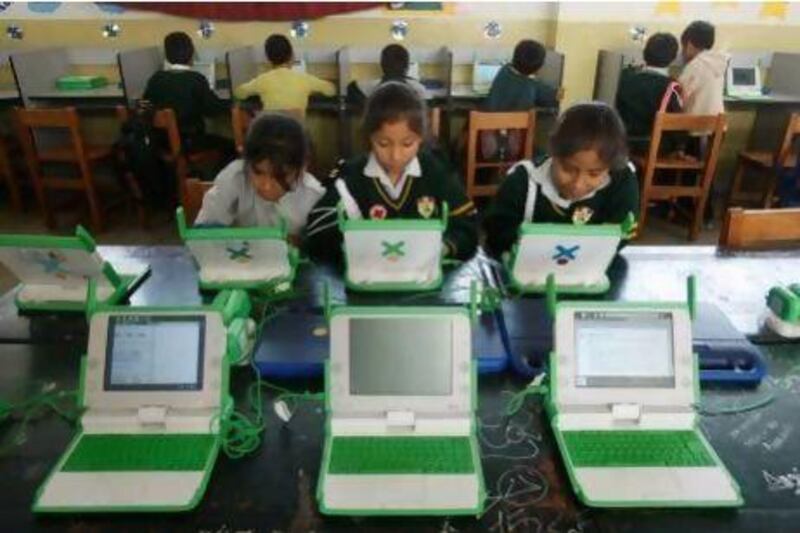LIMA // Peru's distribution of more than 800,000 low-cost laptop computers to children easily ranks as one of the world's most ambitious efforts to use digital technology to fight poverty.
Yet five years into the programme, there are serious doubts about whether the largest single deployment in the One Laptop Per Child (OLPC) initiative was worth the amount, more than US$200 million (Dh73.4m), that Peru's government spent on it.
Ill-prepared rural teachers were often unable to fathom, much less teach with the machines, software bugs didn't get fixed and most had no way to connect to the internet.
Many pupils could not take the computers home as the initiative intended and some schools even lacked electricity.
"In essence, what we did was deliver the computers without preparing the teachers," said Sandro Marcone, the Peruvian education official who now runs the project.
The volume of low-cost computers delivered globally remains modest. Intel Corp says it has shipped more than 7 million, about one in three of them in Argentina. Venezuela has had 1.6 million handed out, licensed from a Portuguese company.
Nicholas Negroponte, the founder of MIT Media Lab, inspired the OLPC initiative. He pioneered the idea that computers could be potent tools for lifting children in the developing world out of poverty. It was unable to achieve the US$100 laptop price tag he desired, but still won adherents.
More than 2.5 million US$200 XO laptops have been distributed by OLPC in 46 countries since 2007.
The rugged, energy-efficient computers, are in Ethiopia, Rwanda, Mongolia and Haiti - and even in the United States and Australia.
Uruguay, a small South American nation of 3.5 million people, is the only country that has given every schoolchild and teacher an XO laptop. No country, however, has bought nearly as many as Peru.
"It's a really great idea," said Jeff Patzer, a software engineer with a degree from the University of California, Berkeley, who, in 2010, visited schools in Peru's rustic Cordillera Blanca highlands introducing and maintaining the laptops. "It just seems like there was some stuff that wasn't thought through quite enough," he added.
Inter-American Development Bank researchers were less polite.
"There is little solid evidence regarding the effectiveness of this programme," they said in a study of 319 schools in Peru.
"The magical thinking that mere technology is enough to spur change, to improve learning, is what this study categorically disproves," said co-author Eugenio Severin, from Chile.
The study found no increased maths or language skills, no improvement in classroom instruction, no boost in time spent on homework and no improvement in reading habits. On the positive side, the access to computers accelerated by about six months students' abstract reasoning, verbal fluency and speed in processing information, the report said.
A study in Ethiopian schools by Dutch researchers, published last year in the journal Computers and Education, also found the laptops improved abstract reasoning and introduced an "information-rich novelty" into an environment starved of learning material.
The Education Ministry official who ran Peru's programme until last year, Oscar Becerra, calls the abstract reasoning findings "spectacular" and disputes claims that the programme has been a failure.
"We knew from the start that it wouldn't be possible to improve the teachers," he said, citing a 2007 census of 180,000 Peruvian teachers that showed more than nine out of 10 lacked basic maths skills, while three in five could not read above sixth-grade level.
In Mr Patzer's experience "most of them barely knew how to interact with the computers at all".






